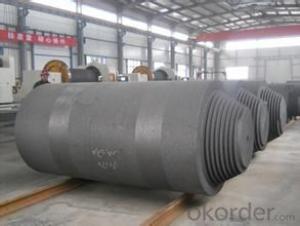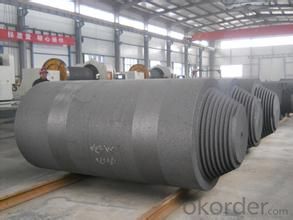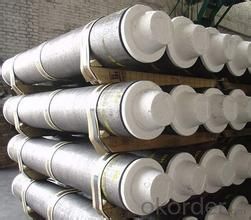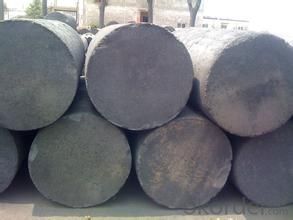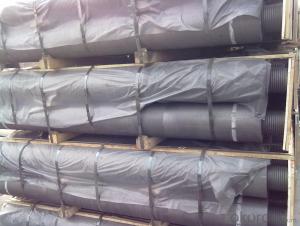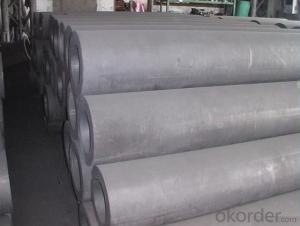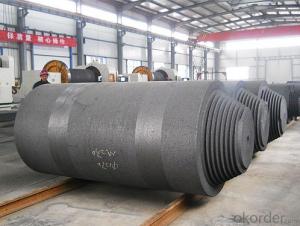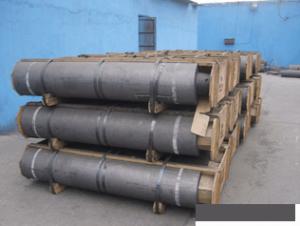Carbon Electrodes with Diameter Φ750~Φ960 RS 38 max
- Loading Port:
- Lianyungang
- Payment Terms:
- TT OR LC
- Min Order Qty:
- 20 m.t.
- Supply Capability:
- 700 m.t./month
OKorder Service Pledge
OKorder Financial Service
You Might Also Like
Spcifications
1:carbon eletrode
2:for ferroalloy,calcium carbide, silicon metal, manufacture
Product Description
Carbon Electrode is abaked electrode used in submerged arc furnaces for delivering power to the charge mix. Electrode is added to the top of the electrode column cylindrical form. Electrode is essentially a mix of Electrically Calcined Anthracite (ECA) or Calcined Petroleum Coke (CPC) with Coal Tar Pitch and is baked for weeks, it is widly used for ferroally productiong, silicon metal production etc.
Graphite/Carbon Electrode Paste Specification:
| PARAMETER UNIT GUARANTEE VALUE | ||||||
| Items | Φ500~Φ700 | Φ750~Φ960 | Φ1020~Φ1400 | |||
| Rs μΩ.m | ≤45 | ≤38 | ≤45 | ≤38 | ≤40 | |
| Bulk Desity g/cm3 | ≥1.55 | ≥1.58 | ≥1.55 | ≥1.58 | ≥1.55 | ≥1.58 |
| Bending Strength MPa | 3.5~7.5 | 4.0~7.5 | 3.5~7.5 | 4.0~7.5 | 3.5~7.5 | 4.0~7.5 |
| Compressive Strength MPa | ≥20.0 | ≥20.0 | ≥20.0 | ≥20.0 | ≥19.0 | ≥19.0 |
| Compressive Strength MPa | 3.2~4.8 | 3.0~4.6 | 3.2~4.8 | 3.0~4.6 | 3.2~4.8 | 3.0~4.6 |
| Ash % | ≤2.5 | ≤2.0 | ≤2.5 | ≤2.0 | ≤2.5 | ≤2.0 |
Picture:
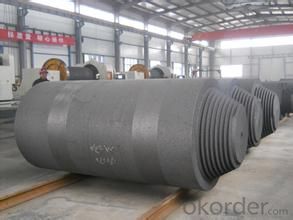
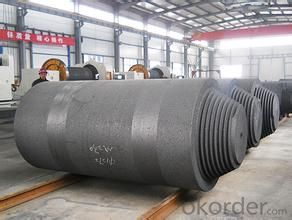
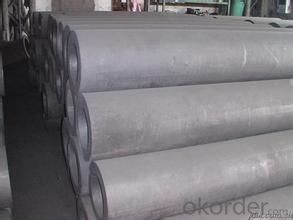
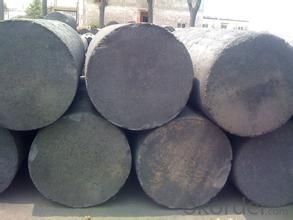
We can adjust the size based on different enquiry. please contact us if you are interested in this materials, we will send our offer as soon as get your kind email.
company information:
China National Building Materials Group is a stated -owned enterprise in charge of administrative affairs in China buiding materials industry.Established in 1984 CNBM is a large group corporation of building materials with total assets of 25 billion and a total stuff of 30000 CNBM now owns 200 subordinating firms of solely owned and joint-venture companies.
- Q: What are the impacts of carbon emissions on the stability of mangroves?
- Carbon emissions have significant impacts on the stability of mangroves. Increased carbon dioxide levels in the atmosphere contribute to global warming and subsequent sea level rise, which directly affects mangrove ecosystems. Rising sea levels reduce the ability of mangroves to absorb wave energy and protect coastlines, making them more vulnerable to erosion and storm damage. Additionally, higher carbon dioxide concentrations can impair the growth and development of mangroves, potentially leading to reduced biomass and overall ecosystem productivity. Therefore, carbon emissions pose a threat to the stability and resilience of mangrove ecosystems.
- Q: What is methane?
- Methane is a colorless and odorless gas that is the primary component of natural gas. It is formed from the decay of organic matter and is a potent greenhouse gas.
- Q: What is the structure of a diamond, a form of carbon?
- The structure of a diamond, a form of carbon, is a crystal lattice arrangement where each carbon atom is covalently bonded to four other carbon atoms in a tetrahedral arrangement. This gives rise to a three-dimensional network of carbon atoms with a repeating pattern. The bonds between the carbon atoms are extremely strong, resulting in the hardness and durability of diamonds. The arrangement of carbon atoms in a diamond forms a cubic crystal system, specifically the face-centered cubic (FCC) structure. This means that each carbon atom is surrounded by a total of eight neighboring carbon atoms, creating a dense and tightly packed structure. The strong covalent bonds and the compact arrangement of carbon atoms in the diamond lattice give rise to the unique properties of diamonds, such as their exceptional hardness, high thermal conductivity, and optical brilliance.
- Q: What is carbon offsetting in the energy sector?
- Carbon offsetting in the energy sector refers to the practice of compensating for the greenhouse gas emissions produced by energy generation and consumption activities. It involves investing in projects or initiatives that reduce or remove carbon dioxide (CO2) or other greenhouse gas emissions from the atmosphere, with the aim of balancing out the emissions being released into the atmosphere. The energy sector is a significant contributor to global greenhouse gas emissions, particularly through the burning of fossil fuels such as coal, oil, and natural gas. Carbon offsetting in this sector aims to mitigate the environmental impact of these emissions by funding projects that promote renewable energy, energy efficiency, and other carbon reduction measures. There are various types of projects that can be supported through carbon offsetting in the energy sector. For example, investments can be made in renewable energy projects like wind farms, solar power plants, or hydropower facilities, which generate clean energy without emitting greenhouse gases. These projects help to displace fossil fuel-based energy sources, reducing overall emissions from the energy sector. Additionally, energy efficiency projects can be supported through carbon offsetting. These initiatives focus on reducing energy consumption by implementing energy-efficient technologies, improving insulation, or optimizing industrial processes. By reducing the amount of energy needed, these projects indirectly lead to lower greenhouse gas emissions. Furthermore, carbon offsetting in the energy sector can also involve the support of initiatives that remove carbon dioxide from the atmosphere. These projects often include reforestation or afforestation efforts, which involve planting trees or restoring degraded forests. Trees absorb and store carbon dioxide through photosynthesis, helping to offset emissions and counteract climate change. Overall, carbon offsetting in the energy sector plays a crucial role in transitioning to a more sustainable and low-carbon future. By investing in projects that reduce or remove greenhouse gas emissions, it allows individuals, organizations, and governments to take responsibility for their carbon footprint and contribute to global efforts in combating climate change.
- Q: How does carbon impact the stability of ecosystems?
- Ecosystem stability heavily relies on the presence of carbon, an indispensable element. Carbon exerts various influences on ecosystems, both directly and indirectly. To begin with, carbon serves as a vital constituent of all living organisms. It plays a pivotal role in the formation of organic compounds like carbohydrates, proteins, and lipids, which are essential for the growth and development of plants and animals. Through the process of photosynthesis, carbon dioxide is converted into glucose by plants, providing organisms with energy. This energy is then transferred through the food chain, sustaining the entire ecosystem. Consequently, the availability of carbon directly affects the productivity and stability of ecosystems. Additionally, carbon dioxide (CO2), a greenhouse gas naturally existing in the Earth's atmosphere, plays a crucial part in regulating the planet's temperature by trapping heat and preventing its escape into space. However, human activities, notably the combustion of fossil fuels, have substantially elevated the concentration of CO2 in the atmosphere, resulting in global warming. This rapid increase in carbon emissions has led to climate change, which poses severe repercussions for ecosystems. Climate change manifests various impacts on ecosystems. As temperatures rise, the distribution and behavior of species are altered, causing changes in their habitats and migration patterns. Consequently, some species may face challenges in adapting, disrupting predator-prey relationships and overall biodiversity within ecosystems. Moreover, climate change can trigger extreme weather events such as hurricanes, droughts, and floods, which can devastate ecosystems. These events disturb resource availability, destroy habitats, and even contribute to the extinction of certain species. Furthermore, heightened levels of carbon dioxide in the atmosphere have resulted in ocean acidification. When CO2 dissolves in seawater, it creates carbonic acid, reducing the ocean's pH level. This acidification negatively impacts marine organisms such as corals, shellfish, and other calcium carbonate-dependent organisms. The diminished availability of carbonate ions in the ocean hampers the formation and maintenance of their structures, ultimately affecting the stability of marine ecosystems. In conclusion, carbon significantly influences ecosystem stability. Its availability and concentration directly impact productivity and energy flow within ecosystems. Moreover, human-induced carbon emissions have triggered climate change and ocean acidification, posing substantial threats to ecosystem balance and functioning. Therefore, comprehending and managing carbon levels in the environment is crucial for preserving the stability and sustainability of ecosystems.
- Q: What is carbon dioxide?
- Carbon dioxide (CO2) is a colorless and odorless gas that consists of carbon and oxygen atoms. It is formed through the combustion of fossil fuels, as well as the natural processes of respiration and volcanic activity. Carbon dioxide plays a crucial role in the Earth's atmosphere as a greenhouse gas, trapping heat and contributing to the planet's overall temperature. While it occurs naturally, human activities such as burning of fossil fuels and deforestation have significantly increased its concentration in the atmosphere, leading to global warming and climate change. Carbon dioxide is also a byproduct of various industrial processes, such as cement production and power generation. Efforts to reduce carbon dioxide emissions are essential to mitigate the effects of climate change and maintain a sustainable environment.
- Q: What is carbon dating and how does it work?
- Carbon dating is a scientific method used to determine the age of organic materials, such as wood, cloth, and bone, by measuring the amount of carbon-14 (C-14) present in the sample. It is based on the principle that all living organisms contain a small amount of radioactive carbon-14, which is formed in the upper atmosphere when cosmic rays collide with nitrogen atoms. This radioactive isotope of carbon is unstable and decays over time, transforming into nitrogen-14. The process of carbon dating begins with collecting a sample from the object of interest. This sample is typically organic matter that was once part of a living organism. The sample is then treated to remove any contaminants and prepared for analysis. In order to determine the age of the sample, scientists measure the ratio of C-14 to stable carbon-12 (C-12) in the sample. This is done using an accelerator mass spectrometer (AMS), a highly sensitive instrument that can detect and measure extremely low levels of C-14. By comparing the C-14 to C-12 ratio in the sample to the known ratio in the atmosphere at the time the organism died, scientists can calculate how long it has been since the death of the organism. The half-life of C-14, which is the time it takes for half of the radioactive isotope to decay, is approximately 5,730 years. This means that after 5,730 years, half of the C-14 in a sample will have decayed into nitrogen-14. By measuring the amount of C-14 remaining in a sample and knowing its half-life, scientists can estimate the age of the sample. Carbon dating is a valuable tool for archaeologists, paleontologists, and geologists as it allows them to accurately determine the age of ancient artifacts, fossils, and geological formations. However, it is important to note that carbon dating is only effective for dating materials up to about 50,000 years old, as beyond this point the amount of C-14 remaining becomes too small to accurately measure.
- Q: What are the impacts of carbon emissions on the stability of grasslands?
- Carbon emissions can have significant impacts on the stability of grasslands. Increased levels of carbon in the atmosphere contribute to global warming, which in turn leads to changes in precipitation patterns and higher temperatures. These changes can result in drought conditions and increased frequency and intensity of wildfires, both of which can destabilize grasslands. Additionally, elevated carbon dioxide levels can promote the growth of invasive plant species, which can outcompete native grasses and disrupt the balance of grassland ecosystems. Overall, carbon emissions pose a threat to the stability and biodiversity of grasslands.
- Q: What are the advantages of carbon-based fuel cells?
- There are several advantages of carbon-based fuel cells that make them a promising technology for the future. Firstly, carbon-based fuel cells have a higher energy density compared to conventional batteries. This means that they can store and deliver more energy per unit weight, allowing for longer operating times and greater power output. This is particularly beneficial in applications where high power density and long-range capabilities are required, such as electric vehicles. Secondly, carbon-based fuel cells have a faster refueling time compared to conventional batteries. While recharging a battery can take hours, refueling a carbon-based fuel cell can be done in a matter of minutes. This is a significant advantage, as it reduces the downtime for refueling and enables a more convenient and efficient usage of the fuel cell technology. Furthermore, carbon-based fuel cells have a lower environmental impact compared to traditional combustion engines. When carbon-based fuel cells are used, the only byproducts are water and heat, making them a clean and environmentally friendly energy source. This is in contrast to internal combustion engines, which produce harmful emissions that contribute to air pollution and climate change. Another advantage of carbon-based fuel cells is their versatility and compatibility with existing infrastructure. They can be easily integrated into existing energy systems, allowing for a smooth transition from fossil fuels to cleaner energy sources. This compatibility makes carbon-based fuel cells a viable option for various applications, ranging from portable electronics to residential power generation. Lastly, carbon-based fuel cells have the potential to contribute to energy independence. As carbon-based fuels can be produced from renewable sources, such as biomass or waste, they offer a sustainable and domestically sourced energy solution. This reduces dependence on foreign oil and enhances energy security for countries. In conclusion, the advantages of carbon-based fuel cells include higher energy density, faster refueling time, lower environmental impact, compatibility with existing infrastructure, and potential for energy independence. With these benefits, carbon-based fuel cells have the potential to revolutionize the energy landscape and provide a sustainable and efficient alternative to conventional energy sources.
- Q: What is the basic principle of carbon fourteen detection?
- There are 3 kinds of carbon isotopes in nature, and their weight ratio is 12:13:14. They are expressed by carbon -12, carbon -13 and carbon -14 respectively. The first two are stable isotopes. Carbon -14 is radioactive. It exists in the atmosphere and is generated in the upper atmosphere by cosmic rays, neutrons, and atmospheric nitrogen nuclei. It combines C4O2 molecules with oxygen in the atmosphere, which is the same as carbon dioxide (CO2). Therefore, it mixes with carbon dioxide to participate in the natural carbon exchange movement. It is absorbed by plants by photosynthesis and stored in plants. People and animals need to eat plants, so they are also stored in human and animal bodies. During the life of the organism, they continuously acquire the radioactive carbon from the atmosphere. But when an animal or plant dies, it stops absorbing and reduces the radioactive carbon in the body. For about 5730 years, its content could be attenuated by half. So physicists call the half-life 5730 years. Therefore, as long as the instruments to measure the trees, grain, animal bones and bone biological remains in the existing carbon content of -14, compared with its original carbon -14 level, you can calculate their death in many years ago, which can be inferred and their coexistence remains (such as construction sites, tombs or other relics how many years have elapsed since).Pro, please [adopted the answer], your adoption is the driving force for my answer, thank you.
Send your message to us
Carbon Electrodes with Diameter Φ750~Φ960 RS 38 max
- Loading Port:
- Lianyungang
- Payment Terms:
- TT OR LC
- Min Order Qty:
- 20 m.t.
- Supply Capability:
- 700 m.t./month
OKorder Service Pledge
OKorder Financial Service
Similar products
Hot products
Hot Searches
